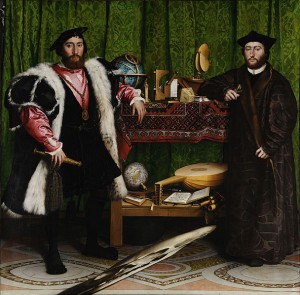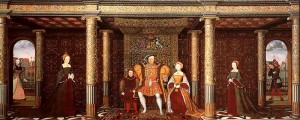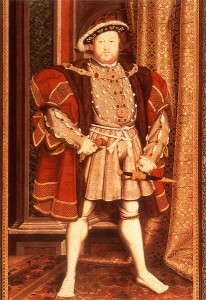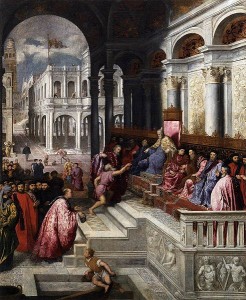I am indebted to Simon Thurley for the plethora of information, diagrams, floor plans and illustrations provided in ‘The Royal Palaces of Tudor England’ – one of my most treasured resources.
I thought I would begin the series with a look at floors, might not seem like an important detail but if we want to visualise the magnificent interiors of the Tudor palaces, then we cannot ignore the flooring.
Floor covering, in general, depended on whether the room or rooms were on the ground floor or not. Generally, those that were on the ground floor and did not have suspended timber floors were floored with ‘tiles, bricks set on the edge or flagstones’ (Thurley, Pg. 230).
The Great Hall at Hampton Court is an exception to this rule and demonstrates that occasionally first floor spaces were also tiled but relied on the existence of a ‘substantial timber sub-floor’ (Pg. 230).
In other instances floors were boarded with oak boards and covered with plaster of Paris. On occasions, this plaster was painted to look like marble or simply covered.
In Holbein’s famous portrait of The Ambassadors, as in the portrait of Henry VIII’s family, the plastered and painted floor is visible.
The most simple of the floor coverings and the one often depicted in films set in Tudor England, was a sprinkling of rushes. According to Thurley, this was the least hygienic option and ‘became increasingly rare as the sixteenth century wore on’ (Pg. 230).
The more common floor covering was the laying of rush mats. According to Thurley, these were ‘mostly made in Southwark, in strips sewn together and close fitted.’ (Pg. 230).
The fact that these mats were in high demand meant that this was a very lucrative business, especially for one John Cradocke who in 1539 obtained a monopoly for life to provide mats for all the royal palaces and lodgings within twenty miles of London (Thurley, Pg. 230).
What is wonderful is that intact early sixteenth century matting was found beneath boards at Hampton Court Palace! Identical matting is shown on the floor of the room where Elizabeth I is receiving ambassadors here.
At times, carpet was also laid on top of mats. This was generally done in an important room or for a special occasion.
The word ‘carpet’ in the sixteenth century,
‘embraced a range of covering fabrics including velvets, needlework, tapestry and embroidery, as well as the knotted pile fabrics regarded as carpet today.’ (Pg. 230)
Inventories of the time show that these hardwearing fabrics were used to cover surfaces like floors, window seats and ledges, and also furniture (Thurley, Pg. 230).
They were usually classified according to their function, for example: foot carpets, table carpets, cupboard carpets, window carpets and carpet cushions (Pg. 230).
Laying carpet on the floor was a sign of status and in full-length portraits of Henry VIII he is always shown standing on one.
Upon his death, Henry owned a huge collection of carpets – over eight hundred!
Of these the majority were of Turkey work although he also owned Ushak and Chintamani rugs.
Here are a couple of examples of the many carpets listed in The Inventory of King Henry VIII.
Item 9751
One Carpet of Turquey makinge wrought with fine Cruell the grounde being redde and a Border the grounde being blacke fringed at thendes withe silke twisted.
Item 15429
A Carpett of crymsen satten allouuer layed with thredes of venice golde in the myddes thereof an embrawderye vppon grene vellat with golde and perles and a brode border aboute the same carpet of grene vellat richelye ebrawdered with golde and perle and roses of like embrawderie within a Rondle of crymsen satten likewise enbrawdred an on eche syde of the same border there is a narrowe border of crymsen satten richelie enbrawdered with damaske golde the same carpet being also frengid rounde aboute with venyce golde and lyned with grene damaske.
ReferencesStarkey, D. (e.d.) 1998, The Inventory of King Henry VIII: The Transcript, Harvey Miller Publishers, London.
Thurley, S. The Royal Palaces of Tudor England, 1993.



















This was an interesting article. I always thought rushes were used most of the time. Thank you for putting this article on you website.
You are welcome Bonnie! Thank you for taking the to leave me a comment
A small company in England called Rush Matters (I have no connection with them but it’s fun to look at their web site) still makes Elizabethan-style rush floor mats, the rush being interwoven with fragrant herbs. Queen Elizabeth I’s favorite herb for this purpose was meadow sweet, also called Queen of the Meadow..